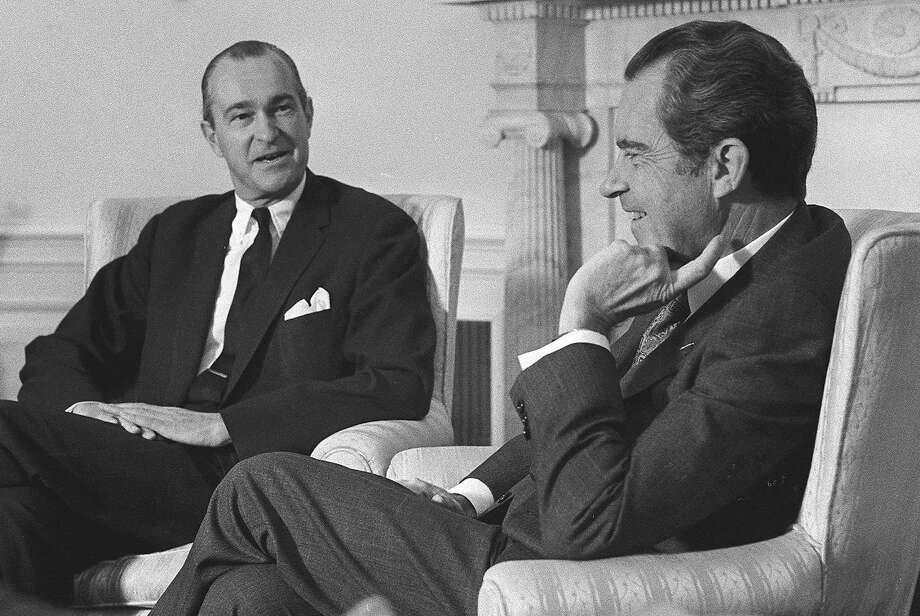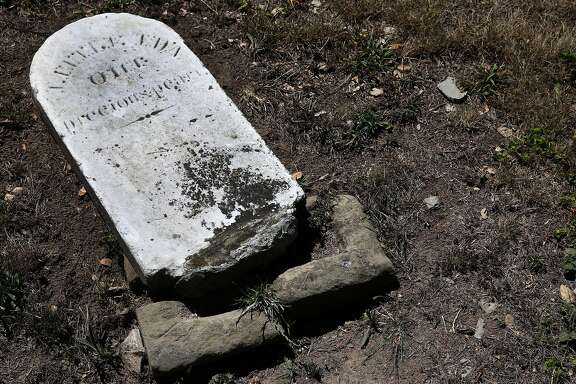When the CIA ran a LSD sex-house in San Francisco
By Gary Kamiya

Photo: AP
Ex CIA official Richard Helms (left), shown with President Richard Nixon in 1973, helped launch the program in the ’50s.
On an elegant dead-end block on the north side of Telegraph Hill is 225 Chestnut St., a swanky modernist building with panoramic bay views. It’s about the last place you would have expected to find a clandestine CIA program during the Cold War.
Yet from 1955 to 1965, this building was the site of “Operation Midnight Climax” — a top-secret mind-control program in which CIA agents used hookers to lure unsuspecting johns from North Beach bars to what they called “the pad,” then dosed the men with LSD and observed the X-rated goings-on through a two-way mirror while sitting on a portable toilet swilling martinis.
As John Marks notes in his 1977 book, “The Search for the ‘Manchurian Candidate’: The CIA and Mind Control,” the CIA’s obsession with mind control had its origins during World War II, when the agency’s predecessor, the Office of Strategic Services, set up a “truth drug” program whose purpose was to discover a substance that would make subjects reveal their secrets.
The drug of choice was a concentrated liquid form of marijuana. The first field test in 1943 was administered to a New York mobster by George White, a tough-guy OSS captain who had been an agent in the Federal Bureau of Narcotics. The results were promising — White’s sidekick said “every (subject) but one — and he didn’t smoke — gave us more information than we had before” — but ultimately inconclusive.
Red enemy
When the CIA was created in 1947, it continued to do mind-control experiments, with the enemy now being communism. Eastern bloc show trials like that of Hungarian Cardinal Jozsef Mindszenty, who in 1949 confessed to crimes he apparently did not commit, and reports of communist brainwashing during the Korean War led the CIA to fear there was a “mind-control gap” and that the U.S. was in second place.
So the CIA authorized covert mind and behavior control programs. Drugs were given to people deemed expendable, including North Korean POWs, mental patients, prisoners, addicts and prostitutes. Before the programs were shot down, hundreds of scientists would work on them.
In 1943, a Swiss chemist named Albert Hofmann developed an unbelievably powerful drug called LSD. When the technical branch of the CIA learned about this drug, the gung-ho head of its chemical division, a young chemist named Sidney Gottlieb, persuaded CIA official Richard Helms that the agency should investigate it as a spy tool. On April 13, 1953, CIA director Allen Dulles approved a program for “covert use of biological and chemical materials” with an initial budget of $300,000. Its name: MKULTRA.
Dangerous game
The CIA began to fund LSD projects at many institutions, including Columbia University and Mount Sinai Hospital. Informed consent and other moral niceties were dispensed with. One researcher kept seven subjects, junkies enticed by promises of hard drugs, on LSD for 77 straight days. No follow-up on them was ever done.
The CIA was playing an extremely dangerous game. In 1953, Gottlieb dosed a CIA colleague, Frank Olson, causing Olson to undergo a mental crisis that ended with him falling to his death from a 10th-floor window. But this horrific incident only put MKULTRA temporarily on hold.
Gottlieb soon hired White, the narcotics agent and former OSS captain, to run two “safe houses” for LSD testing in Greenwich Village. White administered LSD, knockout drops and marijuana to his unwitting “guests” using food, drinks and cigarettes, then tried to get them to talk.
In 1955, White was transferred to San Francisco, where he had worked as a journalist, and rented out the apartment on Telegraph Hill. To give his pad the desired French-whorehouse look, White furnished it with Toulouse-Lautrec posters, a picture of a French can-can dancer and kinky photos of women in bondage and domination poses.
“It was supposed to look rich,” a narcotics agent who regularly visited told Marks, “but it was furnished like crap.”
Watching the show
White installed bugging equipment and a two-way mirror behind which he would sit on a portable toilet, quaffing a martini from the pitcher he kept in the refrigerator, and observe the proceedings. The prostitutes who staffed the operation were paid in part with chits they could use for favors such as getting out of jail.
The CIA was particularly interested in the venerable question of how sex could be used to get a man to talk. At first White and his colleagues wondered if having the prostitute offer some extra sexual service might work, but soon realized that, in the words of an observer, “We found the guy was focused solely on hormonal needs. He was not thinking of his career or anything else at that point.”
The postcoital period was deemed more effective. The men expected the hookers to hurry off, and became emotionally vulnerable when the women said they wanted to stay a few more hours.
Operation Midnight Climax soon expanded beyond the Telegraph Hill pad. CIA operatives began dosing people with acid in restaurants, bars and beaches. They also used other, more exotic drugs: “If we were scared enough of a drug not to try it out on ourselves, we sent it to San Francisco,” a CIA source told Marks. And the agency began using the prostitutes to lure men of all sorts, not just marginal figures, back to the safe house.
Shutting down
The project continued until 1963, when the CIA’s inspector general stumbled upon the safe houses and raised a ruckus. The Chestnut Street pad was shuttered in 1965.
White later recalled, “I toiled wholeheartedly in the vineyards because it was fun, fun, fun. Where else could a red-blooded American boy lie, kill, cheat, steal, rape and pillage with the sanction and blessing of the All-Highest?”
Because the agency destroyed most of MKULTRA’s files, no one will ever know how many lives and minds its illegal and unethical activities damaged or destroyed. (It should go without saying that it achieved none of its murky-at-best research objectives.) Had New York Times reporter Seymour Hersh not exposed the CIA’s illegal spying on Americans in 1974, opening the door to subsequent investigations, this weird and ugly chapter in U.S. history might never have come to light.
Gary Kamiya is the author of the best-selling book “Cool Gray City of Love: 49 Views of San Francisco,” awarded the 2013 Northern California Book Award in creative nonfiction. All the material in Portals of the Past is original for The San Francisco Chronicle. Email: metro@sfchronicle.com
Trivia time
Most recent trivia question: What fabled San Francisco restaurant that opened in 1950 featured 50 different hamburgers on the menu?
Answer: The Hippo at 2025 Van Ness Ave.
This week’s trivia question: What mayor vowed to make San Francisco the “Paris of the West”?
Editor’s note:
Every corner in San Francisco has an astonishing story to tell. Gary Kamiya’s Portals of the Past tells those lost stories, using a specific location to illuminate San Francisco’s extraordinary history — from the days when giant mammoths wandered through what is now North Beach to the Gold Rush delirium, the dot-com madness and beyond. His column appears every other Saturday, alternating with Peter Hartlaub’s OurSF.


